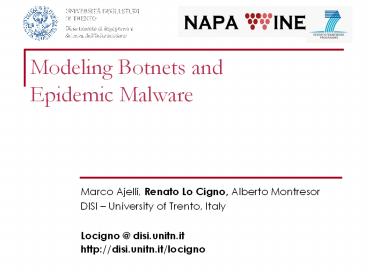Modeling Botnets and Epidemic Malware - PowerPoint PPT Presentation
Title:
Modeling Botnets and Epidemic Malware
Description:
Title: PowerPoint Presentation Last modified by: Renato Lo Cigno Created Date: 1/1/1601 12:00:00 AM Document presentation format: On-screen Show Other titles – PowerPoint PPT presentation
Number of Views:128
Avg rating:3.0/5.0
Title: Modeling Botnets and Epidemic Malware
1
Modeling Botnets and Epidemic Malware
- Marco Ajelli, Renato Lo Cigno, Alberto Montresor
- DISI University of Trento, Italy
- Locigno _at_ disi.unitn.it
- http//disi.unitn.it/locigno
2
BOTNETS
- Collection of bots, i.e. machines remotely
controlled by a bot-master - Today intrinsically associated with malware
- Viruses, worms, ...
- SPAM sending, data spying, ...
- A bot is created by spreading a piece of
software that infects machines - Bot software self-replicate
- Bot Software may be
- Active doing its intended damage/action/...
- Replicating sending new copies to non-infected
machines - Sleeping just waiting to go into one of the
above states
3
Why Modeling Botnets
- To ... improve their design ? ... or
- To understand how to counter them better
- Little is known about how botnets works and
operate - Worms and Viruses are among the most dangerous
threats to Internet evolution - SPAM (90 of it is deemed to be generated by
botnets!) is hampering e-mail communications ...
and can be worse on other services like voice! - Bots can scan the disk to grab, important,
sensitive, personal information - ...
4
How to model a Botnet?
- Intrinsically difficult
- Large, distributed system with complex behavior
- Measures are not available and very difficult to
collect (this limits also the scope of
modeling, since it is not possible to validate
them) - No clues on the dynamic behavior, apart from the
fact that they spread by infection new machines - No space for a proper stochastic model
- Learn from biology diseases spreading
- We propose a model technique based on
compartmental ordinary differential equations
5
Compartmental ordinary differential equations
- Differential Eq. df(x) a f(x)
- The rate of change of e.g. a population is
proportional to its value - Compartment introduce multiple populations
influencing each other - System of coupled differential equations
6
Botnets subject to immunization I-bot
- s susceptibles PCsthat can be infected
- i infected PCs that got the malware and are
spamming - v hidden infected computers which are not
spamming - r recovered computers which were de-malwerized
- p apportioning coefficient between
spamming/hidden nodes regulate the rate of
toggling between states - We normalize the system w.r.t. an arbitrary
transition rate m, which it absolute rate of
transition between states i and v
7
Botnets with re-infection R-bot
- Recovered PCs can be re-infected with some
- Susceptibles can be immunized (antivirus
footprint update, etc. )
8
More complex models ...
- You can find examples/details on Ajelli, M. and
Lo Cigno, R. and Montresor, A., Compartmental
differential equations models of botnets and
epidemic malware (extended version), University
of Trento, T.R. DISI-10-011, 2010,
http//disi.unitn.it/locigno/preprints/TR-DISI-10
-011.pdf
9
Insights and Metrics given by the Model
- What are the admissible parameters for a bot to
work? - Threshold conditions
- What are the spreading parameters that makes a
bot dangerous? - Nice closed form equations
- look for them in the paper
- you do not want a nasty 2 lines equation on a
slide ? - How many PCs will be affected in the population?
- What is the fraction of infected PCs in time?
- What is the amount of damage done by the botnet?
10
Fraction of PCs infected I-bot
- Measures how many PCs will be infected during the
epidemics - Function of the ratio between infectivity b and
recovery g - Three values of p 0.2,0.5,0.8
11
Maximum number of infected PCs I-bot
- Measures the maximum fraction of PCs will
infected during the entire epidemics - Function of the ratio between infectivity b and
recovery g - Three values of p 0.2,0.5,0.8
more infected nodes are active
12
Fraction of infected PCs in time I-bots
Hidden
b 0.5 g 0.25
p decreases
- Active
p decreases
13
R0 and R-botnet diffusion
- I-botnets are probably too simplistic
- Infection always starts, even if it can be
non-effective if the worm/virus is too much or
too little aggressive - R-botnets are more interesting, due to the
possibility that the malware simply do not spread
if immunization is fast enough - R0 gt 1 means that the infection can happen, lt 1
means that the malware is cured before it can do
meaningful harm - Interestingly this fundamental property can be
computed in closed for the model
14
R-botnets areas of effectiveness
- Grey areas are those for which the epidemics will
occur for the given set of parameters
g 0.25
b
b
15
Harm caused by botnets
- How much damage can a botnet cause?
- Are I-bots more dangerous than R-bots or vice
versa? - Are aggressive bots more or less dangerous than
hidden ones?
16
I-bots waves of spam-storm
- Even simple i-bots show very complex behavior
just by changing a parameter like p - Multiple waves of infection can be simply the
consequence of swapping coordinately between
different p values
17
Conclusions
- We have proposed a modeling methodology for
understanding the behavior of botnets - Even simple, deterministic compartmental
differential equations highlight interesting
phenomena and complex behavior - Available measures would enable
- Validation of averages
- Stochastic models
- Botnets are currently one of the major threats in
the Internet, but they covert and complex
behavior lead (possibly) to underestimate their
impact - Read the paper (better the extended version) to
learn more!!
18
THE END
- Thank you!
- Questions?
- Comments?































